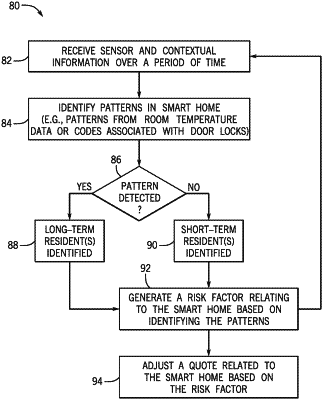| CPC G06Q 50/163 (2013.01) [G06N 20/00 (2019.01); G06Q 40/08 (2013.01); H04L 12/2803 (2013.01)] | 17 Claims |

|
1. A monitoring device, comprising a memory and one or more processors, wherein the memory stores instructions that, when executed by the one or more processors, cause the one or more processors to:
receive, via one or more sensors, maintenance information related to a property, wherein the property and the one or more sensors are remote from the monitoring device;
receive, via the one or more sensors, contextual information related to the property, wherein the one or more sensors comprise: a door lock sensor, a thermostat sensor, or both and wherein the contextual information comprises: a history of door lock code operations reported by the door lock sensor, thermostat temperature changes reported by the thermostat sensor, or both;
train a machine learning engine with the history of door lock code operations reported by the door lock sensor, thermostat temperature changes reported by the thermostat sensor, or both, to distinguish patterns between short term occupancy and long term occupancy;
receive, via one or more user devices, financial information of a user associated with the property;
identify, via the machine learning engine, an indication of whether occupancy of the property is short term occupancy or long term occupancy, the indication of whether occupancy of the property is short term occupancy or long term occupancy based at least in part on whether one or more patterns from the maintenance information, the history of door lock code operations, the thermostat temperature changes, or both the history of door lock code operations, the thermostat temperature changes, and the financial information are identified by the machine learning engine, by:
setting the indication of whether occupancy of the property is short term occupancy or long term occupancy to short term occupancy when the one or more patterns are not identified from the contextual information; and
setting the indication of whether occupancy of the property is short term occupancy or long term occupancy to long term occupancy when the one or more patterns are identified from the contextual information;
identify a risk factor relating to the property, based at least in part upon the identified indication of whether the occupancy of the property is short term occupancy or long term occupancy;
electronically adjust an insurance value in real time or near real-time based upon the risk factor; and
provide, in real time or near real-time, via a graphical user interface, an indication of the adjusted insurance value, the indication of whether occupancy of the property is short term occupancy or long term occupancy and the risk factor and the one or more sensors providing data used to identify the risk factor.
|